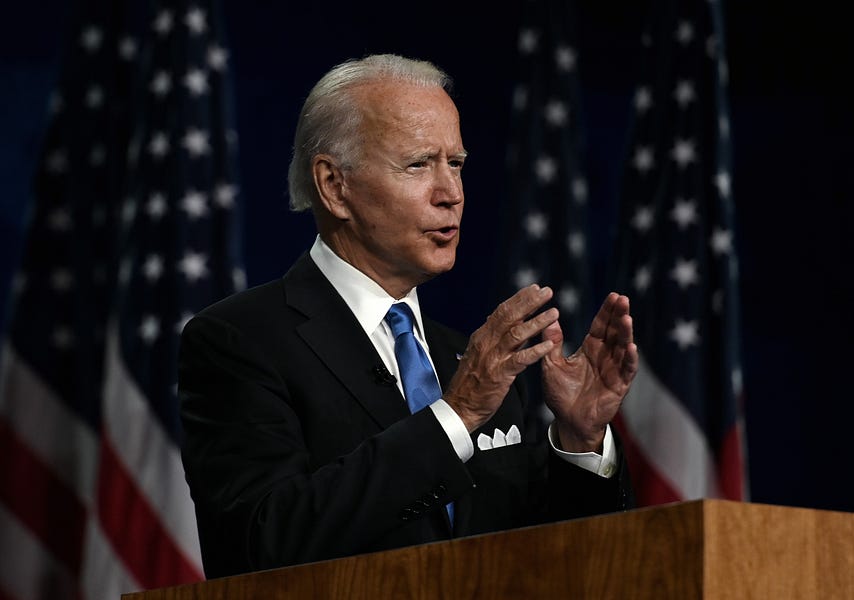Campaign Quick Hits
Win Some, Newsom: It’s all but assured now that there will be a recall election for California’s governor. Recall proponents needed to submit 1.5 valid signatures. The state has already confirmed 1.2 million valid signatures and still has 660,000 signatures left to process. Given that the current signature validity rate is 82 percent, it’s hard to imagine they won’t be able to hit 50 percent with more than half a million left. So what happens now?
Comparing Biden’s 2020 turnout to Newsom’s 2018 election as governor, Biden overperformed Newsom in 57 of California’s 58 counties. And that has opened the door for an obvious strategy for Team Newsom: Blame Trump. Newsom has described the effort as “a partisan, Republican recall—backed by the [Republican National Committee], anti-mask and anti-vax extremists, and pro-Trump forces who want to overturn the last election and have opposed much of what we have done to fight the pandemic.”
And the pro-recall folks certainly want Trump to keep his distance. “I think the less he’s involved in the recall, the better it will be for the recall,” said one organizer. Regardless, recall proponents face an uphill battle. Of the 2 million signatures that were gathered, organizers report that 65 percent were from Republicans and 25 percent were from independents. Only 9 percent were from Democrats. To boot Newsom, they’ll need more than the roughly 24 percent of registered California voters who are Republicans—a number that has been decreasing in recent years.
Polling shows a close-ish race. Emerson reported that 42 percent would vote to keep Newsom and 38 percent would vote to recall him. Not surprisingly, there was a “heavy split along party lines … but 39 percent of independents favored a recall, indicating that the big fight for both camps will probably be for voters who aren’t registered with either party.”
Endorse This: Trump senior advisor Jason Miller told reporter Tom LoBianco the former President has been bombarded with “more than 20 senators and 50 House members calling or traveling to Mar-a-Lago just since January to seek his support.” But those around him are trying to establish order amidst the chaos, with 2020 Trump campaign manager Bill Stepien and Donald Trump Jr. advising the former president “to delay jumping into competitive races, particularly in states such as Ohio, where multiple Trump supporters are vying to win the Republican Party nomination for US Senate.”
In fact, three of the candidates—former Ohio Republican Party chairwoman Jane Timken, former Ohio state treasurer Josh Mandel, and Hillbilly Elegy author J.D. Vance—are all headed down to Mar-a-Lago this week for an early audition that may feel a little like a new season of The Bachelor.
And the next episode may feature the race to replace retiring Alabama Senator Richard Shelby. Rep. Mo Brooks spoke at the rally on Jan. 6 and will be endorsed by former White House adviser Stephen Miller this week. But Lynda Blanchard, who was Trump’s ambassador to Slovenia, held a fund-raiser last week at Mar-a-Lago.
Trump’s endorsement may be the only primary that counts on the Republican side. “If Trump makes it clear that he anoints a particular candidate, it’s going to be difficult to defeat that candidate in a Republican primary,” Jess Brown, professor emeritus at Athens State University, told Bloomberg.
Pennsylvania and North Carolina will have their own ring-kissing ceremonies soon enough. But to whom will the former President give his red rose when he has to pick?
You’re So Money: You can always tell when a campaign or committee knows they’ve won the money race, because they send out a press release seconds after the filing deadline instead of waiting for the report to become public a couple weeks later. Lo and behold, the Democratic National Committee must have been feeling pretty good this week, reporting that it “raised the most it ever has in January and February at $18.4 million.” Winning two Senate races in Georgia was no doubt good for business, but the numbers are also a big coup for newly elected DNC chair Jaime Harrison, the Democrats’ candidate in South Carolina who raised a mind-blowing $131 million before losing by 10 points to Lindsay Graham. But the most important number to come out of their press release was that “the committee has $43 million in cash on hand, twice any previous high point at this stage in the year.” On the flip side, no word from the RNC yet.
The Trump Bump: Trump giveth and Trump taketh away. The New York Times more than doubled and the Washington Post tripled their number of digital subscribers during The Donald’s term in office. But the Post now reports that their number of unique visitors fell 26 percent in February compared to January. CNN lost 45 percent of its prime-time audience, MSNBC lost 26 percent, and the Times lost 17 percent. Fox, on the other hand, only lost 6 percent.
In the meantime, Edelman, a global communications firm, released their annual poll on institutional trust, which found that “an epidemic of misinformation and widespread mistrust of societal institutions and leaders around the world” has “driven trust in all news sources to record lows.” The organization found social media (35 percent) and owned media (41 percent) to be the least trusted sources, while “traditional media (53 percent) saw the largest drop in trust at eight points globally.”
As media critic Andrew Tyndall told the Post, the question for legacy media outlets is, “at heart, do they think of themselves as authoritative or tabloid? Joe Biden will not offer them the same get-out-of-jail-free card that allowed them to fudge the difference.”
C.W.L. Stirewalt (feel free to take your middle name guesses to the comments section) is channeling the nascent re-elect campaign this week to think about what they are seeing and how confident they are heading into 2024:
Biden 2024: The Bidening
So how is Joe Biden doing, really?
Here I don’t mean how he is doing from your ideological view or even really at the fundamentals of being president, but rather how well Americans believe he is doing. Presidential job approval tends to have a pretty low correlation to actual job performance outside of times of crisis, but it has a very high correlation to the presidents chances of re-election. The three presidents who have sought reelection this century have ended up with shares of the national vote within a whisker of their pre-election job approval ratings.
Gallup is the gold standard on presidential approval not just because the firm uses the right methods, but because Gallup has been tracking the metric since Harry Truman took office 76 years ago. While some survey questions, e.g. right-track/wrong-track numbers, have lost their savor in our era of slavish partisanship, presidential approval remains salient. The independent voters who decide every election may not be inclined to dive in on other estimations, but nearly every potential voter has an opinion on the way the president is doing his job. Just like presidential elections themselves, the question draws in lower-propensity voters who tend to be less ideological.
Before the 2004 election, George W. Bush scored a 48 percent approval rating before winning a bit more than 50 percent of the vote. In 2012, Barack Obama had a 52 percent approval rating and got 51 percent of the vote. In 2020, Donald Trump had a 45 percent approval rating and got just short of 47 percent of the vote.
Biden seems an unlikely candidate for a second term given how old he’ll be on Election Day 2024 (83)—but then again, his age made him an unlikely choice in 2020. Like the fellow running from the bear said to his friend, Biden doesn’t need to be an empirically good candidate, he just needs to outrun the other guy. Given the massive, stupid civil war Republicans seem intent on having and the degree to which Democrats are so far willing to ride the rails with Amtrak Joe, at the very least we cannot rule out the possibility. And it’s undeniable that public perceptions of Biden’s success or failure will have a direct impact on how likely he is to get his increasingly ambitious agenda passed.
At this point in his presidency, Donald Trump was lugging a 40 percent approval rating after a bleak inauguration and a chaotic start. Obama was very much still in his honeymoon at this point in 2009, with 63 percent of adults approving of the way he was handling the job. It is Bush whose first springtime in office seems the most like Biden’s. Bush was at 58 percent in the first half of March 2001. Biden is riding 54 percent this time. That shouldn’t come as a surprise. Both ran on the message of bipartisan cooperation and a restoration of the office of the presidency and were rewarded by voters exhausted by scandal, corruption and constant drama.
Biden is certainly in the pink compared to his immediate predecessor, but like Bush, Biden lacks a mandate for sweeping change. Democrats may be excited about the possibility of a double-barreled spending package of about $3 trillion Biden is now pushing, but that looks far out of the reach of a caretaker president with approval ratings in the mid-50s. However, Biden is more of a gambler than Bush was at this point.
If public satisfaction with Biden’s response to the coronavirus and the economy continues to rise, who knows what might be possible by the end of this year? At the very least, Republicans had better take seriously the chance that they may be battling a popular president over whether or not to give Americans more “free” money—an issue on which their own party seems increasingly divided.
A Beef Over Beef
On a slow day, I read roughly 250 headlines, three dozen or so full news stories, 5 newsletters, and a zillion tweets. I love longform journalism—and I read a lot of it—but it’s rare that I find a political longform that immerses me into a world I didn’t already know. Tim Alberta does it regularly, as does McKay Coppins, and obviously there’s our own Declan Garvey. But otherwise political longforms are usually just long interviews with a candidate that is at best faux candid.
But last week, I stumbled across a piece that is bound to be one of the best longforms of 2021. “Red Meat. It’s What’s for Dinner in Colorado Politics” was written by Nick Bowlin, a Colorado-based correspondent for High Country News who published this piece for Politico Magazine. The story is ostensibly about a “MeatOut” proclamation from Democratic Governor Jared Polis, declaring that Coloradoans should avoid eating meat on March 20. As Bowlin noted, this proclamation “was symbolic, containing no policy authority.”
But “MeatOut” was about much more than a simple proclamation. It was about what happens on the ground when a purple state goes blue.
Colorado voted for George W. Bush—the guy who explicitly ran against gay marriage—twice. And now it has a gay, Democratic governor with a vegan First Gentleman. But the state still has 13,000 beef cattle producers that process over 2 million cattle and close to $4 billion in sales each year.
But this isn’t really a beef over beef. It’s about grey wolves being reintroduced by a ballot measure “with two-thirds majorities in Denver and Boulder, while the counties in Western Colorado where the wolves will be reintroduced rejected it soundly.” It’s about an influx of new voters from neighboring states who are “educated, wealthier, drawn to Denver’s fast-growing tech, finance, cannabis and aerospace sectors.” And it’s about a Colorado Democratic Party that doesn’t need cattle ranchers anymore to win statewide.
Polis is up for reelection in 2022. I’ll be watching to see whether he even fields a real opponent given the trends in the state. And longer term, I’ll be watching to see what happens when a previously powerful group of swing state voters realize they aren’t swingers anymore.








Please note that we at The Dispatch hold ourselves, our work, and our commenters to a higher standard than other places on the internet. We welcome comments that foster genuine debate or discussion—including comments critical of us or our work—but responses that include ad hominem attacks on fellow Dispatch members or are intended to stoke fear and anger may be moderated.
With your membership, you only have the ability to comment on The Morning Dispatch articles. Consider upgrading to join the conversation everywhere.